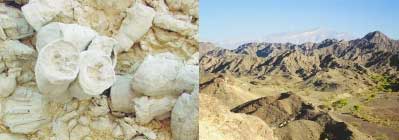OMAN - a geological wonderland
Oman |
Expenses in Oman |
Tourism |
Tenders|
Associations |
Oman forum |
NRI |
Jobs |
Ministries|
Links
English Arabic translation |
OIFC Electric Water bills|
Asian Beach games 2010|
Omani Labour law
References:
Citizen & Residents |
Business |
Visitors |
Online Payments |
Useful information
![]()
Coumnists:
Sangeetha
Sridhar,
Dr.Rajan Philips,
Hasan Kamoonpuri
Newspapers:
Times of Oman,
Oman Observer,
Oman Tribune,
The Week

By Conrad Prabhu - “Learning about Oman’s
geological heritage will lead you to love this country more, and to support
its sustainable development,” resident geoscientist Prof Janos L Urai began
as he took his audience of geology enthusiasts on a riveting journey back in
time through millions of years of geological history.
The roughly hour-long public talk, held at the German University of
Technology in Oman (GUtech) last week, began on the cusp of pre-history when
the landmass that was to eventually become Arabia was covered by water,
hemmed in by moving continents, carved by ancient rivers and scoured by
monstrous glaciers.
Those geological processes, occurring over hundreds of millions of years,
left behind a spectacular legacy in ophiolites, anticlines, unconformities,
and other anomalies (not to mention sizeable hydrocarbon deposits) that
makes Oman in many ways a geological wonderland.
But understanding and appreciating this splendid heritage is key to
preserving it for future generations, Prof Urai said, as he invited his
audience to be more aware of Oman’s geological riches the next time they set
out to explore the country’s rugged countryside. “There’s more to see as you
drive around in your 4-wheel-drive or travel around Oman,” Prof Urai, who is
Dean of the Faculty of Science and Head of the Department of Applied
Geosciences at GUtech, pointed out.
At the outset of his presentation, the geoscientist highlighted the
pre-eminent role of water in Oman’s geological history. A visit to any major
wadi system will provide a geological record of major flood events of the
past, evident in the layers of erosion seen along the edges of the wadi.
Studying past flood trends, he noted, was indispensable to planning any
developmental activity in the area.
Another geological marvel is the Rimal al Sharqiyah (formerly known as
Wahiba Sands) whose formation Prof Urai attributed to climate change after
the last Ice Age. The vast sand sea, he said, consists of big and small
dunes, with the big dunes underlying the smaller ones.
The dunes of Rimal al Sharqiyah, the geoscientist noted, also provide useful
insights for those looking to study the hydrocarbon potential of a given
area. Pores in the sand hold clues to the presence of either water or
hydrocarbons, either of which is a valuable resource. But with modern tools
and technologies, such as satellite imaging, seismic reflection and modern
drilling techniques, the quest for oil and gas has come a long way from the
time when more rudimentary methods were in vogue, he said.
An equally significant geological curiosity is the ophiolite, a mass of rock
that was once part of the ocean crust and obducted on to the landmass
millions of years ago. Entire mountains made up of this dark looking rock
can be found in north Oman, and even closer home, in the vicinity of Muttrah
Souq and around Al Bustan Palace InterContinental, he said.
While ophiolites can also be found in other parts of the world, the Oman
phenomenon is notably unique because of the existence of pillow lavas — the
product of molten lava that solidified when the Arabian landmass was still
under water in times bygone. Wadi Jizzi in the Batinah region is home to
some of the world’s most striking examples of pillow lava formations, he
said.
On the next leg of Prof Urai’s geological tour, the audience was introduced
to geological quirks in the Jabal Akhdar and Jabal Shams areas that truly
attest to Oman’s spectacular geological heritage. Fossils and other
geological features dating from the Cretaceous to the Jurassic periods can
be found in and around Wadi Nakhr, a dramatic gorge located 3,000 metres
above sea level in Jabal Akhdar.
Not far from here, near Wakan Village, natural history buffs can check out
an unconformity denoting 300 million years of non-activity in Oman’s
geological evolution. Pre-Cambrian and Mesozoic rocks abound in the area.
Other geological anomalies include the anticline — a sequence of rock layers
that are progressively older at the core of the fold.
Jabal Shams has its own share of geological wonders, according to Prof Urai.
Along the rim of the canyon are Cretaceous and Jurassic era rock layers,
while elsewhere can be found rock veins — exposed fractures that have the
semblance of rock art. Importantly, the study of Oman’s exceptional
geological heritage has benefits that go beyond the search for hydrocarbons,
says Prof Urai.
Equally prospective — from the economic and employment standpoints — is the
huge tourism potential linked to this wealth. “Oman with its diverse
geological heritage is one of the best places on Earth where a geoscientist
can choose to be, providing employment opportunities not only in the
hydrocarbons industry, but in tourism as well,” he stated.
Courtesy:
http://www.main.omanobserver.om/


